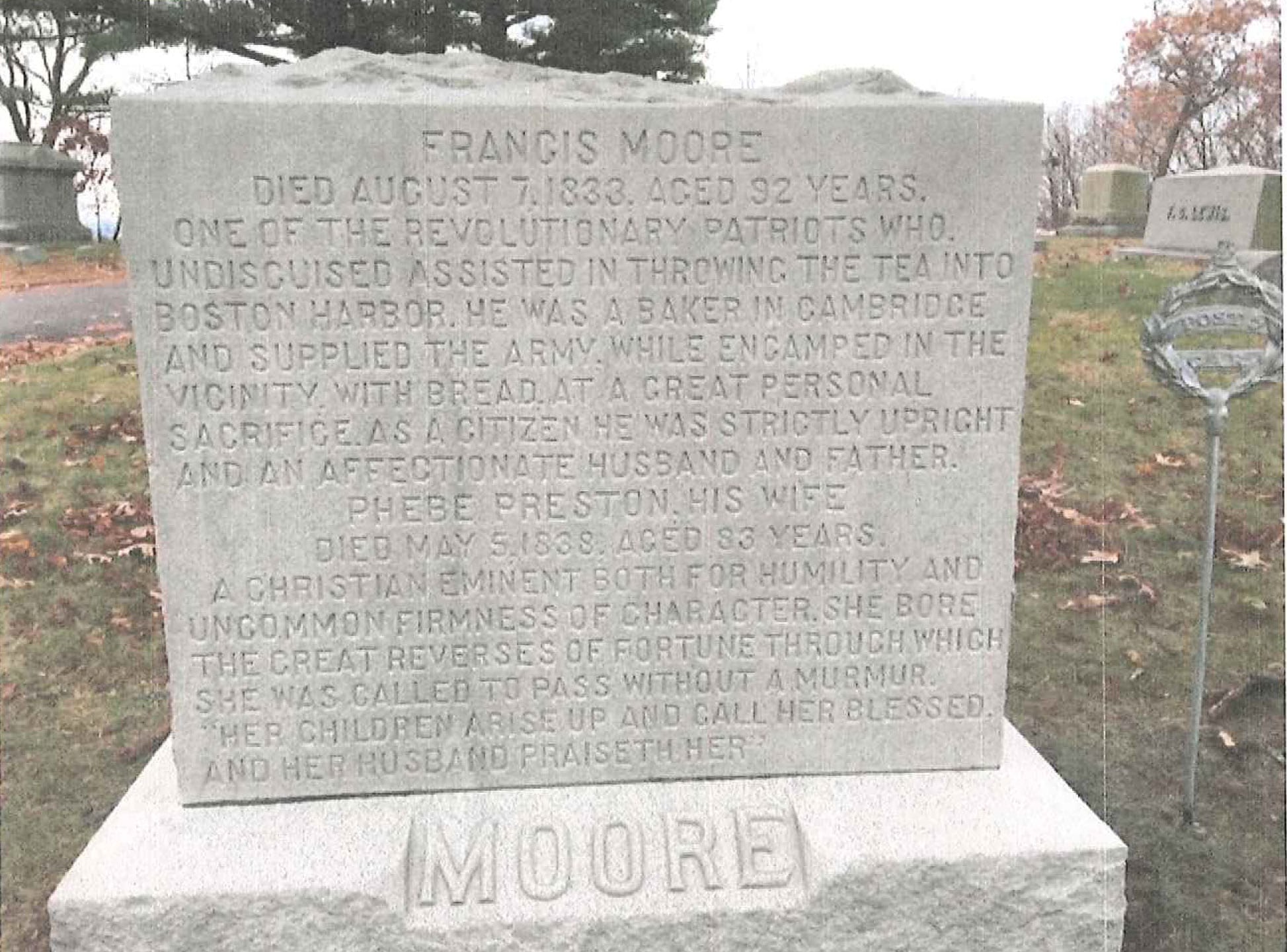LYNN — Although he’s not widely known like other patriots of his time, Lynn’s own Francis Moore played an integral part in the Boston Tea Party. And he is buried right in Pine Grove Cemetery.
Two hundred and forty-six years later, Moore will finally get recognition for his efforts during a ceremony at Pine Grove Cemetery on Thursday at 11 a.m., when a commemorative medal that declares him a Boston Tea Party participant will be placed on his gravestone.
The event will also feature reenactors from the Dec. 16, 1773 protest, when more than 100 patriots dumped 342 chests of tea into the Boston Harbor in response to what they felt were unjustified British taxes, which included a tax on tea, according to history.com.
Unlike other participants, who referred to themselves as the “Sons of Liberty” and tried to conceal their identities by dressing in Native American garb, which was meant to symbolize defiance and independence, or darkening their faces, Moore took part in the crucial protest without a disguise. That anomaly is noted on his headstone.
“Francis Moore saw no need to do that,” said Evan O’Brien, creative manager at Boston Tea Party Ships & Museum. “He was willing to risk his own personal reputation and safety for the cause.”
Moore, who died in 1833 at age 92, was a baker by trade who lived in Cambridge. His other contributions included providing free bread to the Continental Army during the American Revolution, according to O’Brien, which earned him the appreciation of George Washington, the army’s commander who later became the nation’s first president.
Following the war, Moore moved to Lynn, where he spent the rest of his life. He was part of the prominent Breed family, who sold part of the cemetery to the city after the Civil War so its deceased residents could be buried, according to Arthur Dulong III, chairman of the Pine Grove Cemetery Commission.
“We thought it would be a nice gesture to celebrate one of our own,” said Dulong. “I think this is good for the city of Lynn. We can start off the new year with a nice little ribbon on our shirts.”
Dulong hopes the ceremony will jumpstart a larger effort of the Pine Grove Cemetery Commission, which is to restore the long-vacant Rhodes Memorial Chapel. If restored, weddings and funerals could be held in the building, he said.
The Romanesque Revival style chapel was built in 1889 and has not been used since 1962. Its projected $1 million restoration, which would include rebuilding the chapel’s stained glass windows, adding heat, and renovating its interior, has been a goal of the commission for more than a decade, said Dulong.
The last major push was several years ago when Pine Grove Cemetery was added to the National Register of Historic Places. The designation opened up the opportunity for matching funds and grants for the project, said Dulong.
“It really is a centerpiece — it’s gorgeous,” said Dulong. “We do not have a chapel, a place for services now. This is why we want to get underway.”
The ceremony is one of many throughout the state since last year. Organizers from the Boston Tea Party Ships & Museum decided to mark the 245th anniversary of the protest by identifying and honoring its participants at cemeteries throughout the country, many of whom are buried in New England.
More than 80 markers have been placed and the museum’s goal is to have 150 placed by the 250th anniversary. However, many of the participants remain unknown, said O’Brien, who explained some chose not to identify themselves for fear of prosecution or had sworn an oath at the time not to reveal who was involved.
Despite the secrecy, O’Brien said some Colonial rebels identified themselves in other common ways, such as bragging about their involvement in the protest that sparked the American Revolution to friends and families.
Many people are aware of revolutionary patriots such as John Hancock, Paul Revere and Samuel Adams, but the Boston Tea Party was largely carried out by ordinary citizens, said O’Brien.
“Ordinary citizens did extraordinary things,” said O’Brien. “We’re honored to be able to work with Lynn and be able to spread the knowledge of the Boston Tea Party across the Commonwealth. Our hope is that people who come across these medallions in cemeteries will take a moment to reflect on the people who made extraordinary contributions to our history.”

